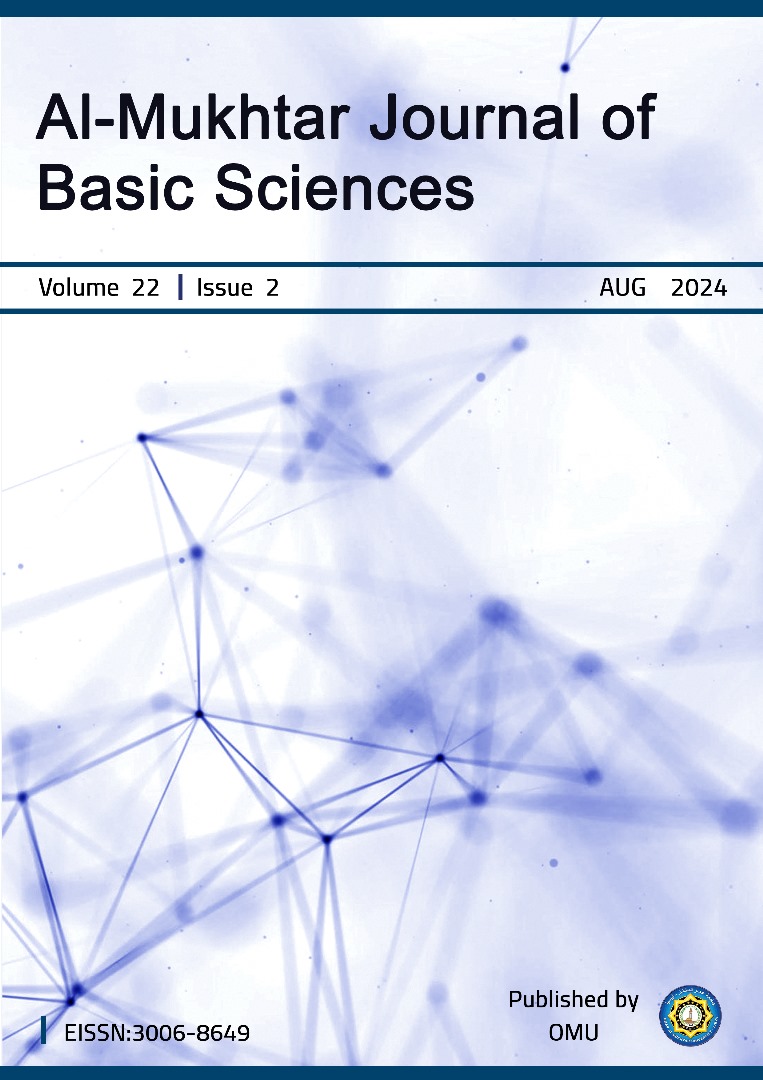Detection Staphylococcus aureus contaminated some door handles and table surfaces and their sensitive to antibiotics
DOI:
https://doi.org/10.54172/2vgx1j05Keywords:
Contamination , Table's Surfaces , Door Handles , Laboratories, S.AureusAbstract
The current study's objective was to identify and isolate Staphylococcus spp. germs from a few of Omar Al-Mukhtar University's faculty laboratories. It is regarded as the first investigation carried out at Omar Al-Mukhtar University to assess the level of Staphylococcal bacterial contamination of door handles and table surfaces inside the laboratories. 33 isolates from the College of Science's Botany Department were used in the study, which took place in the department's laboratories during the fall semester of the academic year (2022). After evaluating the expanding colonies and using morphological inspections and biochemical tests to diagnose the isolates, it was showed that 90.9% of the samples from the Botany Department were Staphylococcus and that the percentage of S. aureus reached 36.7% of isolates of Staphylococcus. A biofilm-forming capacity was demonstrated by 80% of the isolated bacteria, of which 29% were S. aureus. In order to ascertain the effectiveness of the antibiotics and which ones the bacteria are resistant to, the sensitivity of thirty S. aureus isolates to hospital-grade antibiotics against infection was tested. The findings revealed a high level of resistance to the majority of antibiotics and a definite resistance to gentamicin. Methicillin-resistant MRSA isolates made up 73.3% of the isolates, whereas vancomycin-resistant VRSA isolates made up 70%.
References
Ahmed, M. O., Abuzweda, A. R., Alghazali, M. H., Elramalli, A. K., Amri, S. G., Aghila, E. S., & Abouzeed, Y. M. J. L. J. o. M. (2010). Misidentification of methicillinresistant Staphylococcus aureus (MRSA) in hospitals in Tripoli, Libya. 5(1).
Aiello, A. E., Marshall, B., Levy, S. B., Della-Latta, P., Larson, E. J. A. a., & chemotherapy. (2004). Relationship between triclosan and susceptibilities of bacteria isolated from hands in the community. 48(8), 2973-2979.
Ayuba, L., Suwange, M., Enefiok, U. J. I. J. o. M. S., & Technology. (2019). Bacterial contamination of door handles/knobs in gombe state university, Nigeria. 4(8), 204-211.
Baron, E. J., Peterson, L., & Fenigold, S. (1994). Diagnostic Micobiology.(9th edn.) Mosby Publication. In: USA.
Chakraborty, S. P., KarMahapatra, S., Bal, M., & Roy, S. J. A. A. J. M. S. (2011). Isolation and identification of vancomycin resistant Staphylococcus aureus from post operative pus sample. 4(2), 152-168.
Darwish, S. F., & Asfour, H. A. J. T. S. W. J. (2013). Investigation of biofilm forming ability in Staphylococci causing bovine mastitis using phenotypic and genotypic assays. 2013(1), 378492.
Domínguez, E., Zarazaga, M., & Torres, C. J. J. o. c. m. (2002). Antibiotic resistance in Staphylococcus isolates obtained from fecal samples of healthy children. 40(7), 2638-2641.
Erfani, M., Ghasemi, D., Mirnejad, R., & Piranfar, V. (2015). Incidence and antibiotic susceptibility pattern of Staphylococcus spp. in urinary tract infections (UTI), Iran, 2013-2014.
Forrest, G. N., & Tamura, K. J. C. m. r. (2010). Rifampin combination therapy for nonmycobacterial infections. 23(1), 14-34.
Habib, F., Rind, R., Durani, N., Bhutto, A. L., Buriro, R. S., Tunio, A.,…Sciences, B. (2015). Morphological and cultural characterization of Staphylococcus aureus isolated from different animal species. 5(2), 15-26.
JF, M. J. L., Williams, & Williams, B. (2000). Biochemical tests for identification of medical bacteria.
Lowy, F. D. J. N. E. j. o. m. (1998). Staphylococcus aureus infections. 339(8), 520-532.
Morris, S. J., & Blackwood, C. B. (2024). The ecology of soil biota and their function. In Soil microbiology, ecology and biochemistry (pp. 275-302). Elsevier.
Nazarchuk, O. A., Nahaichuk, V. I., Osadchuk, N. I., Dmytriiev, D. V., Dmytriiev, K. D., & Turzhanska, O. S. J. W. L. (2020). Prognostic parameters of the susceptibility of Staphylococcus spp. to aminoglycosides and doxycycline. 73(8), 1615-1619.
Noel, C. d. C., Silvério, F. M., Francisco, N. L. d. S. G., Almeida, N. R. d., & Soares, L. d. C. J. R. b. c. s. (2017). Suscetibilidade antimicrobiana e fatores de virulência de Staphylococcus em fômites do hospital universitário sul fluminense. 245-254.
Otto, M. J. C. o. i. m. (2014). Staphylococcus aureus toxins. 17, 32-37.
Otto, M. J. N. r. m. (2009). Staphylococcus epidermidis—the'accidental'pathogen. 7(8), 555-567.
Shukla, S. K., & Rao, T. S. J. B. (2017). An improved crystal violet assay for biofilm quantification in 96-well microtitre plate. 100214.
Todar, K. G. (2004). Todar's online textbook of bacteriology. Kenneth Todar University of Wisconsin-Madison Department of Bacteriology.
Tsopmene, U. J., Iwewe, Y. S., Eyong, I. M., Bisso, B. N., & Dzoyem, J. P. J. C. (2023). Antibiotic Resistance Profile, Biofilm Formation Ability, and Virulence Factors Analysis of Three Staphylococcus spp. Isolates From Urine. 15(4).
Umeanaeto, P. U., Okafor, U. C., Unam, M. C., Ilo, C. C., Okoli, C. C., Afulukwe, S. C.,…Sciences, L. (2021). Assessment of parasites and bacterial contamination of office door handles in nnamdi azikiwe university, Awka, Anambra State. 9(2), 120-127.
Vaez, H., Tabaraei, A., Moradi, A., & Ghaemi, E. A. J. A. J. M. R. (2011). Evaluation of methicillin resistance Staphylococcus aureus isolated from patients in Golestan province-north of Iran. 5(4), 432-436.
Wayne, P. (2011). Clinical and laboratory standards institute. Performance standards for antimicrobial susceptibility testing.
Yeh, P. J., Simon, D. M., Millar, J. A., Alexander, H. F., Franklin, D. J. O. p. h., & perspectives, r. (2011). A diversity of Antibiotic-resistant Staphylococcus spp. in a Public Transportation System. 2(3), 202-209.
Downloads
Published
Issue
Section
License
Copyright (c) 2024 Wafa A. Triki, Hosnia Boufarwa , Nagah S. A. Abubaker (Author)

This work is licensed under a Creative Commons Attribution-NonCommercial 4.0 International License.
Copyright of the articles Published by Al-Mukhtar Journal of Basic Sciences (MJBS) is retained by the author(s), who grant MJBS a license to publish the article. Authors also grant any third party the right to use the article freely as long as its integrity is maintained and its original authors and cite MJSc as the original publisher. Also, they accept the article remains published by the MJBS website (except in the occasion of a retraction of the article).












